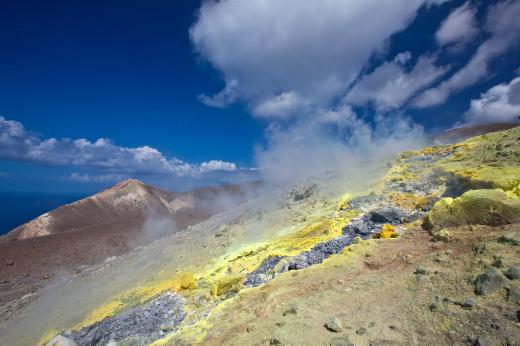What Is Hydrosulfuric Acid?
Hydrosulfuric acid is a highly toxic chemical compound that is made when hydrogen sulfide is dissolved in water. Classified as a weak acid, hydrosulfuric acid's strongest distinguishing feature is its strong smell, reminiscent of rotten eggs, giving it the nicknames of "stink damp" and "sewer gas." Present in large quantities in the earth's crust and known also as sulfhydric acid, it is not only a large part of volcanic emissions but is also present in many fossil fuels including both crude oil and natural gas. Although both contain hydrogen and sulfur, hydrosulfuric acid is a very different chemical from sulfuric acid.
To make hydrosulfuric acid, hydrogen sulfide gas must be dissolved into water. Each of its molecules contains two hydrogen atoms and one sulfur atom, giving it a molecular weight of 34.08. The acid itself is considered relatively weak, especially when compared with sulfuric acid. While the pH of sulfuric acid is an extremely low 1.0, hydrosulfuric acid's pH is 4.5, putting its relative strength somewhere between bananas and tomato juice.

Hydrogen sulfide is present in many fossil fuels. In fact, one of the easiest ways to produce it is to simply separate it from "sour gas," a natural gas that is adulterated with as much as 90 percent hydrogen sulfide. Although it is less prevalent in crude oil, it is nevertheless frequently present. Its presence in well water in the form of sulfhydric acid can be dangerous, requiring it to be oxidized with ozone or a manganese filter to render it inert and non-toxic.
Sulfhydric acid is not a frequently produced or heavily used chemical compared with other acids due to its limited number of uses. Although it can be made by a process involving the burning of elemental sulfur with hydrogen, hydrosulfuric acid can also be reversed back into elemental sulfur. Chemists also use it as an analytical tool due to its ability to detect the presence of metallic elements in solutions. Other applications include using it to separate heavy water, a type of water made with deuterium instead of hydrogen that is useful in certain nuclear reactors, from regular water.
As toxic as cyanide, hydrosulfuric acid is a dangerous chemical, especially in its gaseous form. One of its most dangerous characteristics is that it has a strong and unpleasant odor in harmless low concentrations but deadens the human sense of smell in higher, toxic, concentrations. The British used it as a chemical warfare agent in World War I, and it was involved in a cluster of suicides in Japan in 2008. Some paleontologists think that it played a major role in the mass extinction at the end of the Permian period, approximately 250 million years ago.
AS FEATURED ON:
AS FEATURED ON:











Discuss this Article
Post your comments